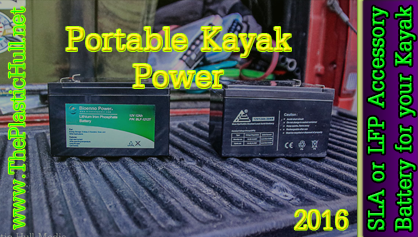Waterproof Kayak Battery Box Mods & Upgrades
 This article illustrates how to modify and wire a 12V plug port and a USB receptacle for charging electronic devices such as cell phones and running GoPro’s with out an internal battery for an all day charge. Using the existing waterproof battery box from a previous article we will first replace the 12V 12 aH Sealed Lead Acid (SLA) Battery. See SLA or LFP Accessory Battery for your Kayak write up for the differences in batteries and pros/cons of both. I have opted to now use a LFP battery for its long list of great qualities.
This article illustrates how to modify and wire a 12V plug port and a USB receptacle for charging electronic devices such as cell phones and running GoPro’s with out an internal battery for an all day charge. Using the existing waterproof battery box from a previous article we will first replace the 12V 12 aH Sealed Lead Acid (SLA) Battery. See SLA or LFP Accessory Battery for your Kayak write up for the differences in batteries and pros/cons of both. I have opted to now use a LFP battery for its long list of great qualities.
Products & materials you will need.
- About two feet each red & black of 16ga shielded copper electrical wire


- (10) Spade Connectors (Blue 14 – 16ga)
- (1) 3 Way Female Double Male Spade Connector
- (2) Inline Fuse Holder w/ 16ga wire
- (2) 3 – 5 amp fuses (Most fish finder electronics recommend 3 amp)
- (1) 12V Marine Power Outlet
- (1) 12V Double USB Receptacle
- (1) Hopkins 2 pole plug (For Fish Finder Connection)
- (1) On Off Switch (I used a stainless steel product to last with the salt water)
- (3) Butt Connectors
Instructions:
 First thing you will do is remove the existing battery and all of the wiring in the box. We are going to replace everything inside. Keep the cable gland as it will be reused.
First thing you will do is remove the existing battery and all of the wiring in the box. We are going to replace everything inside. Keep the cable gland as it will be reused.- Using a hole saw drill match up the diameter to the outside of the hole saw with the two receptacles. Try to keep the holes even and equal distance apart for aesthetic reasons. After drilling the holes trim the excess from the edge of the holes. Set the receptacles and tighten the collar down.
- Drill a hole using a hole saw that matches the diameter of the switch in your desired location. Make sure the internal protrusion will not interfere with the battery or the 12V receptacles. Install the switch.
 Now we will splice 2 wires together to connect the negative side and the positive sides of the receptacles together. Make one for each RED and BLACK.
Now we will splice 2 wires together to connect the negative side and the positive sides of the receptacles together. Make one for each RED and BLACK.- Connect the spade connectors to the correct terminals on the receptacles + with + and – with -.
- Using a butt connector connect the RED + wire from the Fish Finder Plug to one inline fuse.
- Using the 3 Way Female to 2 Male connector connect the Two Inline Fuses to the Male ends and the White 12V Positive from the switch with a male spade to the female end on the 3 way its good to tape this connection with electrical tape or purchase a insulated connector.
- Connect the Red + wire from the switch using a female spade connector to the battery.
 Connect the BLACK – wires by crimping on a female spade connector from the 12V receptacles, the 12V Fish Finder connection and the black wire from the switch together. Simply twist the (3) wires together feed into the hole on the connector and crimp using the crimping tool.
Connect the BLACK – wires by crimping on a female spade connector from the 12V receptacles, the 12V Fish Finder connection and the black wire from the switch together. Simply twist the (3) wires together feed into the hole on the connector and crimp using the crimping tool.- Then Connect the Female Spade with the (3) black wires to the – Negative side of the battery.
Upon Completion:
Test by pressing the switch to the ON position. The LED Indicator should light up. Test all receptacles and that the fish finder powers up. You now have a portable waterproof kayak battery box with the option to run additional lighting on your kayak, Charge electronics, and run cameras VIA USB power.
This concludes the Kayak Battery Box modifications & Upgrades article. Please leave comments on your thoughts!











